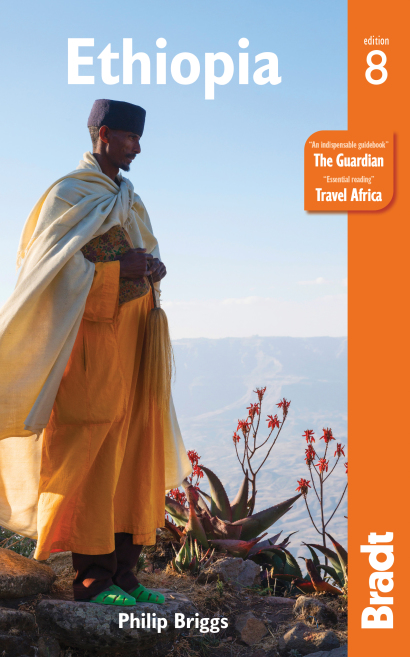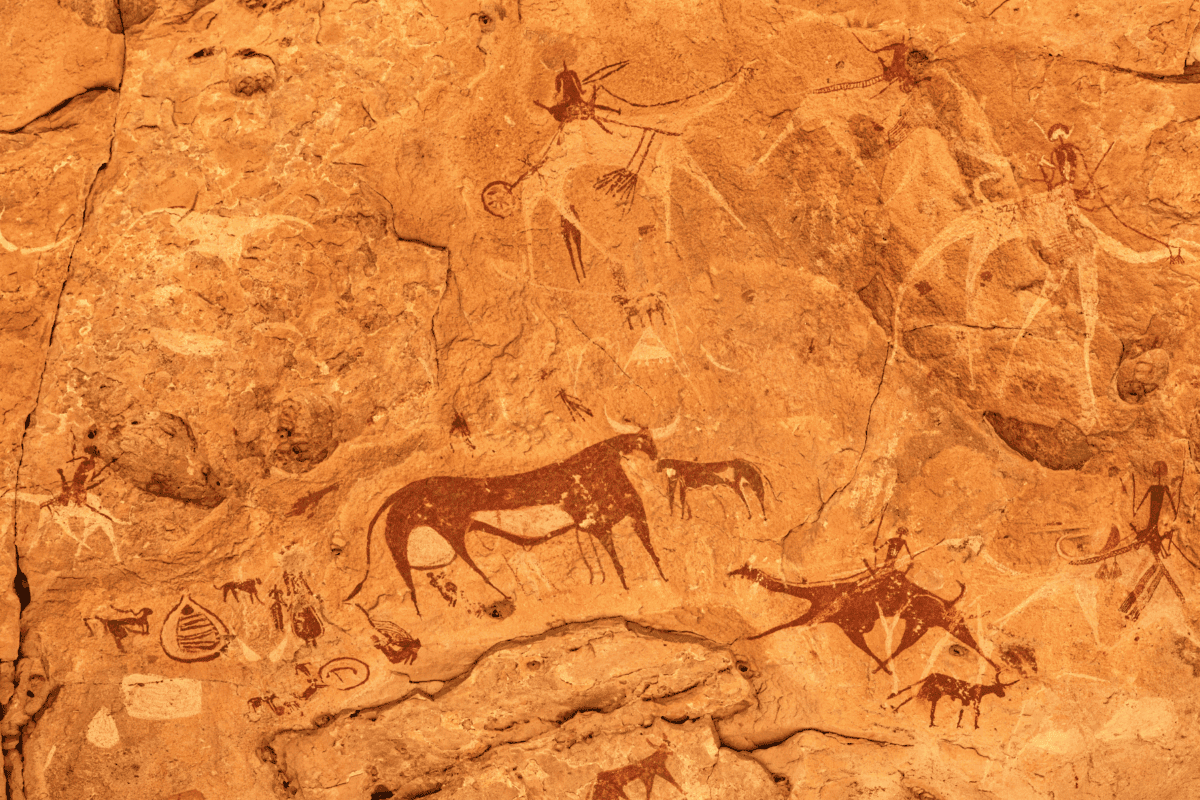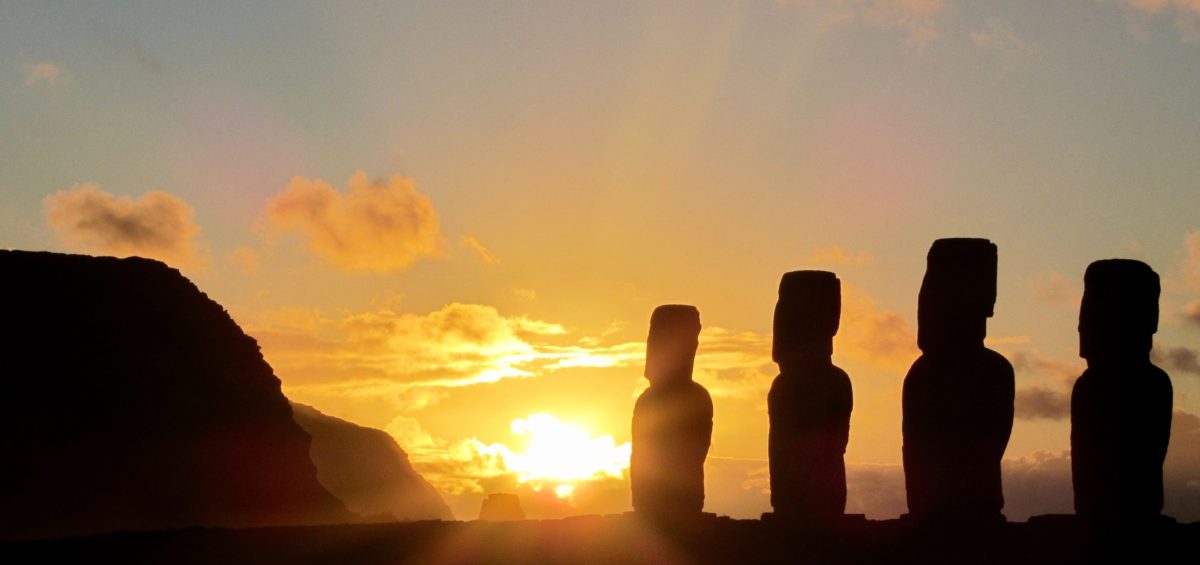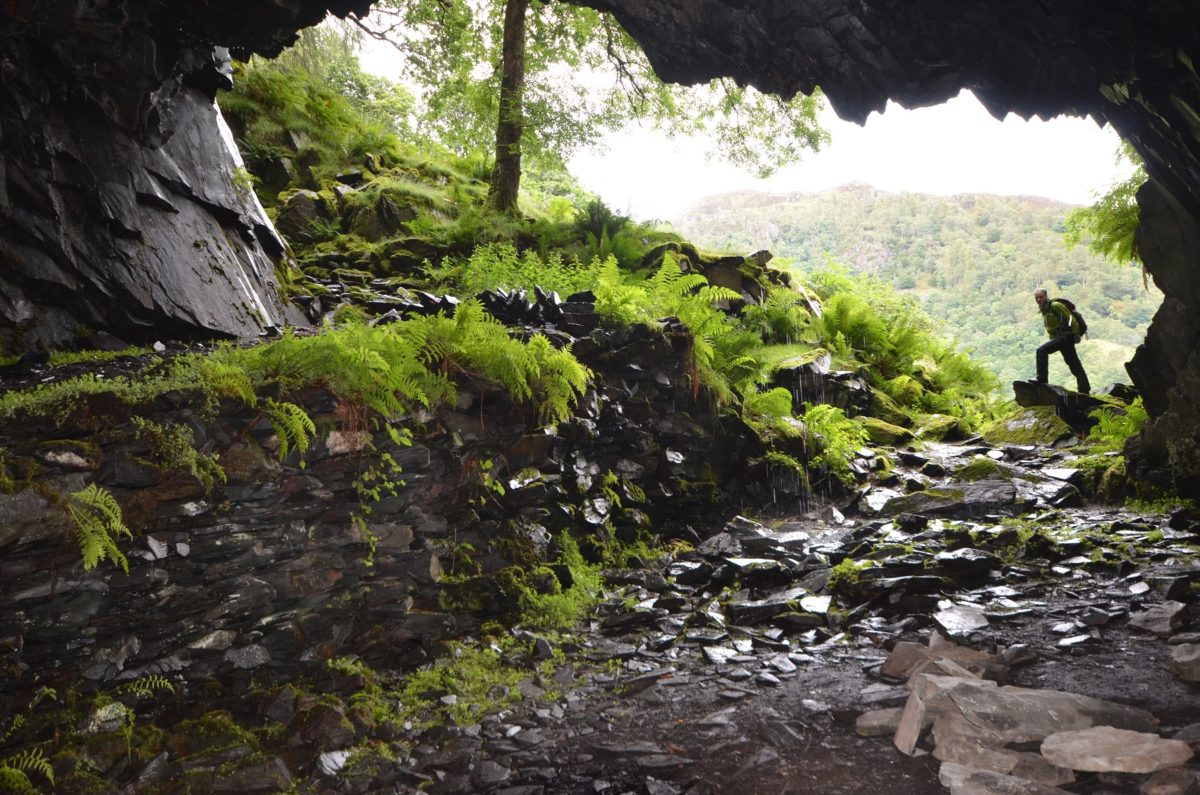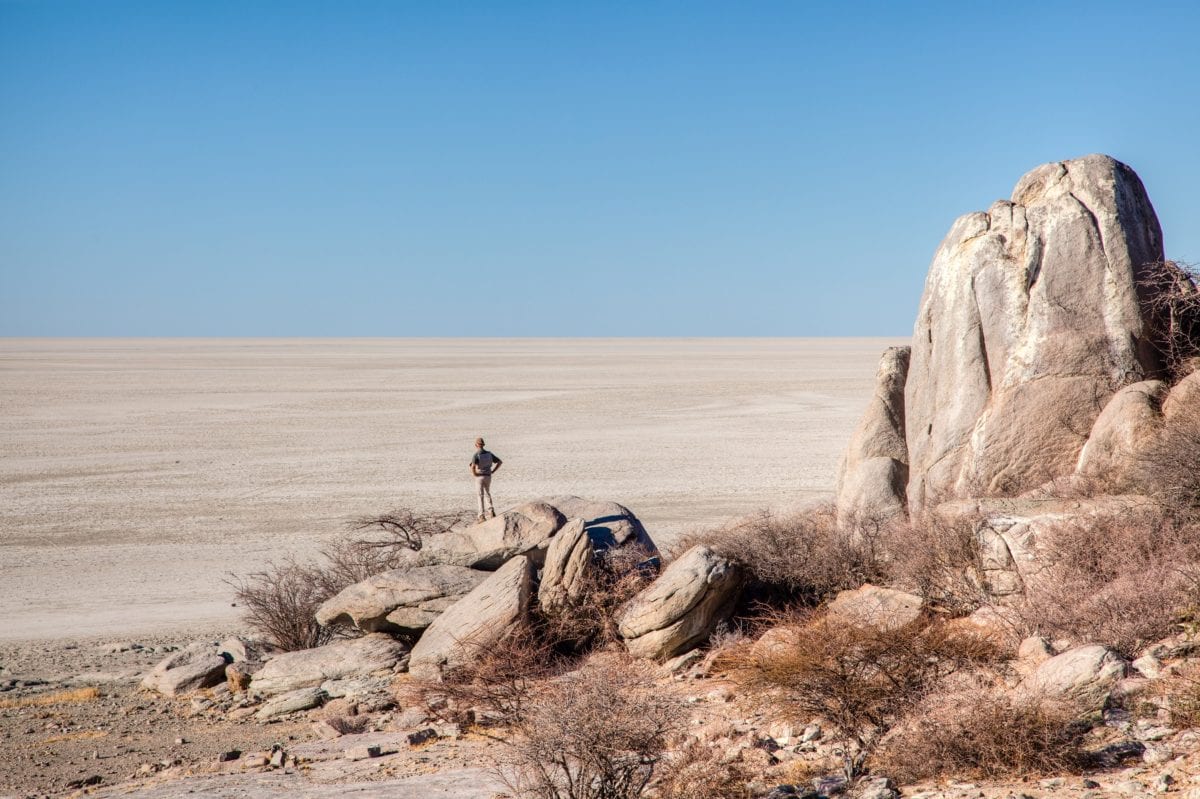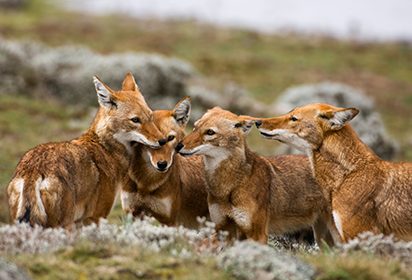Practically every tangible facet of Ethiopian culture is unique. Obscured by the media-refracted glare of the surrounding deserts, Ethiopia feels like the archetypal forgotten land.
Philip Briggs, author of Ethiopia: the Bradt Guide
Ethiopia is the most misunderstood of African countries, and also one of the world’s most underrated travel destinations. Though not really suited to a conventional holiday, Ethiopia will reward adventurous travellers with all the riches of a land believed to be the cradle of humankind.
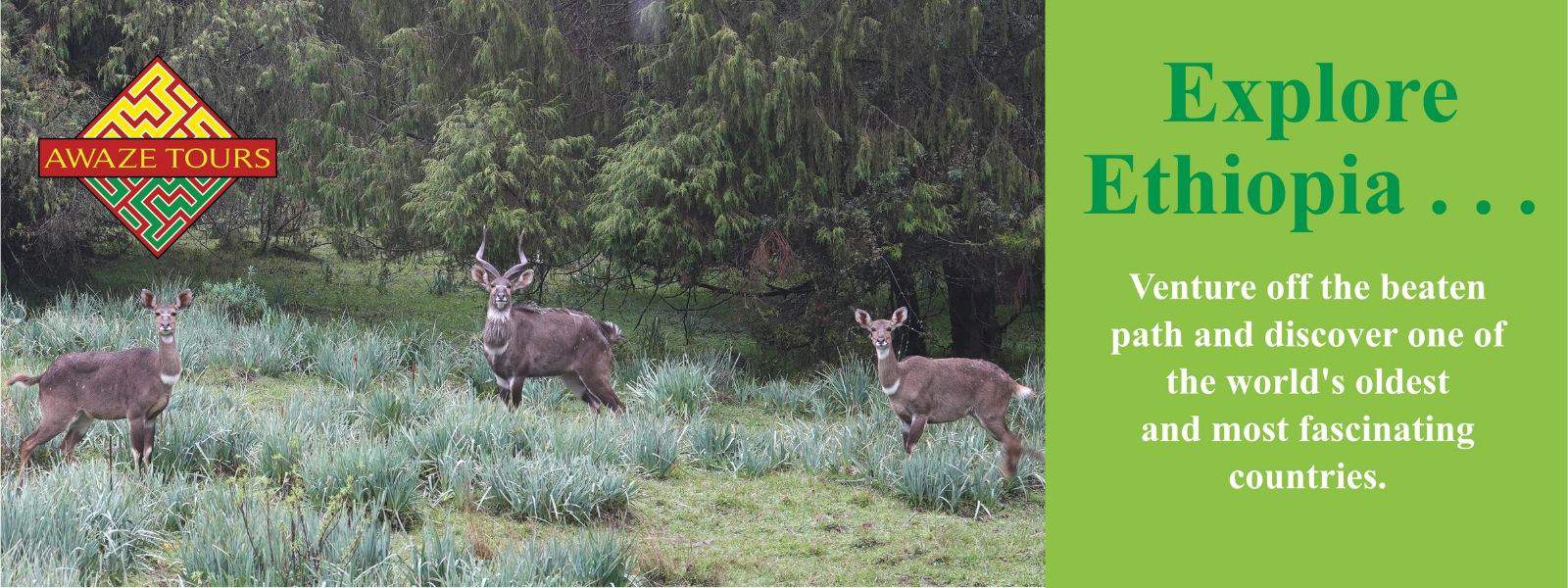
Ethiopia’s low-key tourist industry revolves around the richest historical heritage in sub-Saharan Africa. The town of Axum, its outskirts studded with giant stelae and ruined palaces, was once the centre of an empire that stretched from the Nile River across the Red Sea to Yemen between the 1st and 7th centuries ad. The medieval capital of Lalibela boasts a cluster of hand-carved rock churches regarded by many as the unofficial eighth wonder of the world. There is also Gonder, the site of five 17th-century castles built by King Fasil and his successors. And all around the country are little-visited centuries-old monasteries and other rock-hewn churches, many imbued with an atmosphere that seems positively Biblical.
Although historical sites are the focal point of tourism, they often threaten to be swamped by the breathtaking highland scenery, which embraces the kilometre-deep Blue Nile Gorge, the sculpted sandstone cliffs and valleys of Tigrai, the lush forests of the west and south, and the lake-studded volcanic landscape of the Rift Valley floor. Elsewhere, mountainous national parks such as Bale and Simien provide refuge to endemic creatures ranging from the Ethiopian wolf and oddball gelada monkey to several dozen bird species found nowhere else in the world. Equally unique to this most strange and rewarding country are the wonderfully fiery cuisine, the peculiar pentatonic music, and the shoulder-shuddering dances performed in local bars.
For more information, check out our guide to Ethiopia:
Food and drink in Ethiopia
Food
To anyone who has travelled elsewhere in Africa, Ethiopian food comes as a welcome revelation. Instead of the bland gristle and starch that is the standard restaurant fare in most African small towns, Ethiopian food is deliciously spicy and you can eat well virtually anywhere in the country. Contrary to many people’s expectations, most of Ethiopia is fertile, food is easy to find and portions are generous and very cheap. At local eateries, you’ll often find that one plate of food will be adequate to feed two.
Ethiopian dishes
A wide variety of different dishes is available in Ethiopia. Most of them are unique to the country, so it is worth familiarising yourself with their names as soon as you arrive. The staple source of carbohydrates in Ethiopia is injera, a large, pancake-shaped substance made from tef, a nutty-tasting grain that is unique to Ethiopia and comes in three varieties: white, brown and red. The tef dough is fermented for up to three days before it is cooked, the result of which is a foam-rubber texture and a slightly sour taste reminiscent of sherbet. Injera is normally served with a bowl of wat stew. The ritual is to take a piece of injera in your hand and use it to scoop the accompaniment into your mouth. If you dine with Ethiopians, it is normal for everyone to eat off the same plate.
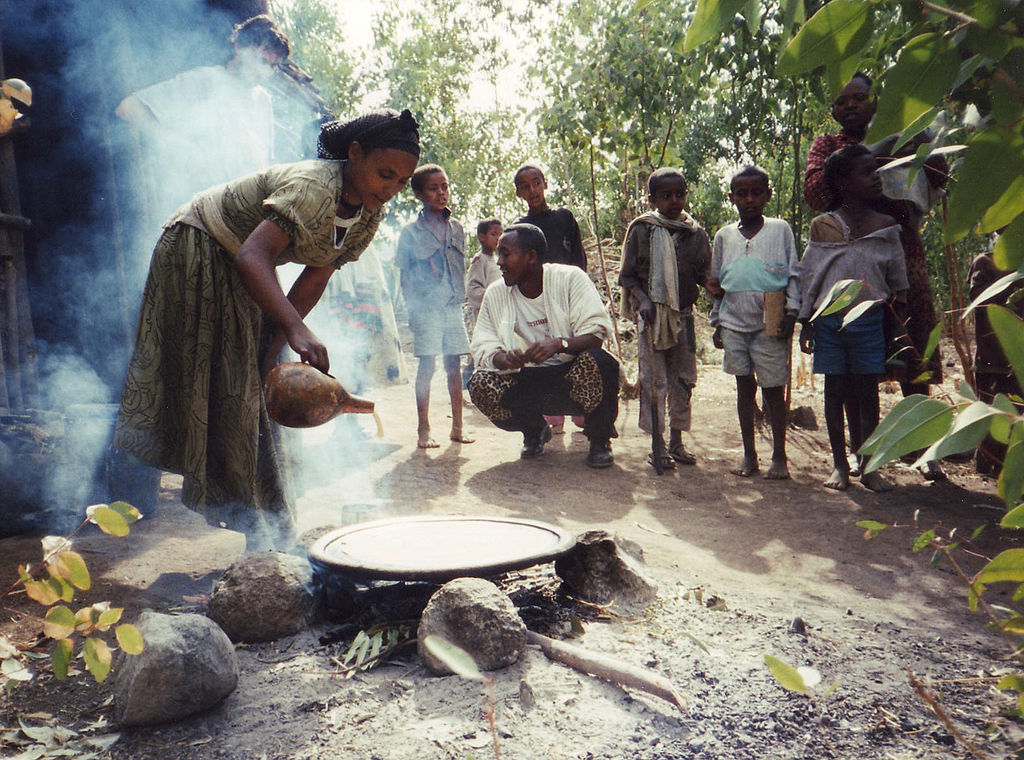
The most common non-vegetarian accompaniment to injera is a dish called tibs (or more properly siga tibs, literally ‘meat fried’), which as its name suggests consists of freshly flash-fried meat, spiced moderately and mixed in with onions and peppers. Tibs is often served with a spicy red powder called mitmita on the side, or with awaze, a sauce made from beriberi (powdered chilli) together with lime juice, salt, olive oil and a drop of whisky or wine. Particularly recommended is shekla tibs, where the fried meat is served in a clay pot that contains a charcoal burner.
The most common meat in the highlands is lamb (bege), while in drier areas you will most often be served with goat (figel). Beef (bure) is also eaten, mostly in large towns. In towns near lakes, fish (asa) predominates. You might also come across tripe wat, which is made with tripe but pronounced trippy. The official national dish
of Ethiopia, doro wot is made with chicken, but is best avoided if you’re hungry, as it is traditional to serve only a lonely drumstick or wing in a bowl of sauce. Normally kai wat consists of meat boiled in the kai sauce, but you may also come across tibs kai wat, which means the meat was fried before the sauce was added. If the meat is minced prior to cooking, then the dish is known as minje tabish.
Drink
Given that the Kaffa province of Ethiopia is thought to be where coffee originated, and the coffee bean accounts for more than half of Ethiopia’s exports, it should be no surprise that Ethiopians are coffee mad. The local espresso-style coffee (buna), served with two spoons of sugar, is rich, sweet and thoroughly addictive. Coffee with milk is buna watat. In small towns, sweet tea (shai) is more widely available than coffee.
You’ll often be invited to join a traditional coffee ceremony, in which the grains are roasted over charcoal, ground while the water is boiled, then used to make three successive pots of coffee. It’s not advisable to accept if you’re in a rush or want to get any sleep (it is rude to leave before the third round has been drunk), but you should certainly experience it at least once in your trip. Despite the pomp you might associate with the word ‘ceremony’, it’s really just a social thing – instant coffee holds little appeal in a country where few people have jobs, or even television.
The usual soft drinks – Coca-Cola, Pepsi, Fanta – are widely available and very cheap. The generic name for soft drinks is leslasa. The Harar Brewery also produces a non-alcoholic malt beverage (apparently aimed at the Muslim population) called Harar Sofi, which tastes similar to cola and is said to be good for an upset stomach.
A little more surprisingly, carbonated mineral water is bottled locally and is widely available for around US$0.60 per 750ml bottle. It is best to ask for mineral water by brand name, which is Ambo in central, south and western Ethiopia, and Babile (pronounced ‘bubbily’ – not sure if this is coincidence!) in the east. Still water is also available. The major brand is called Highland, and you will often hear roadside children screaming this repeatedly in the hope that you will toss them an empty bottle (which you most certainly should not!). Another (and arguably better-tasting) top brand is Abyssinia.
Ethiopia’s prime soft drink is fruit juice, which is really puréed fruit. What is available depends somewhat on season and location, but the most common juices are banana, avocado, papaya, orange and guava. I highly recommend the avocado, which sounds odd but is delicious with a squeeze of fresh lime and is sometimes layered with grenadine syrup. If in doubt, ask for espris, which consists of layers of all available juices. The result is thick, creamy, healthy and absolutely fantastic. A glass of juice generally costs less than US$1.
The most popular local tipple is tej, a mead-like drink made from honey (mar) or sugar (isukalama). Mar tej is a considerable improvement on most African home brews, and very alcoholic, but personally I couldn’t get into it on a daily basis. Isukalama tej is entirely avoidable. Tej is not served in normal bars; you will have to go to a tej abet to drink it. A 750ml bottle of tej costs around US$1. Locally brewed beer, made from millet or maize, is called tella. This is similar to the local brew of east and southern Africa, and no less foul in Ethiopia than it is elsewhere in the region.
Health and safety in Ethiopia
Health
Ethiopia, like most parts of Africa, is home to several tropical diseases unfamiliar to people living in more temperate and sanitary climates. However, with adequate preparation, and a sensible attitude to malaria prevention, the chances of serious mishap are small. To put this in perspective, your greatest concern after malaria should not be the combined exotica of venomous snakes, stampeding wildlife, gun-happy soldiers or the Ebola virus, but something altogether more mundane: a road accident.
Within Ethiopia, adequate (but well short of world-class) clinics and hospitals can be found in Addis Ababa and a few other major centres, while functional doctor’s rooms (known as ‘higher clinics’), laboratories and pharmacies are available countrywide. Wherever you go, doctors and pharmacists will generally speak passable English, and consultation and laboratory fees (in particular malaria tests) are inexpensive by international standards – so if in doubt, seek medical help.
Safety
Ethiopia is generally a very safe country. Casual theft and pickpocketing are fairly commonplace in parts of the country, most notably Addis Ababa, but this sort of thing is almost never accompanied by violence. In Addis, pickpockets might operate anywhere, but favoured areas are the Mercato, and in the vicinity of government hotels in the city centre. Violent crime isn’t a cause for serious concern, but as in any large city one should not wander around at night with a large amount of money or important documents.
In other parts of Ethiopia, the risk of encountering pickpockets is mainly confined to bus stations and markets, and even then only in larger towns. At bus stations, this is most likely to be a loner operating in the surge of people getting onto a bus. In the streets, a favoured trick is for one person to distract you by bumping into you or grabbing your arm, while a second person slips his fingers into your pocket from the other side. It’s advisable to leave valuables and any money you don’t need in a hotel room, to carry the money you do need in a relatively inaccessible place, and to always turn quickly in the other direction if somebody does bump into you or grab you.
Thieves often pick up on uncertainty and home in on what they perceive to be an easy victim. In Addis Ababa, where there are plenty of experienced thieves and con artists, always walk quickly and decisively. When you arrive in a new town by bus, stroll out of the bus station quickly and confidently as if you know exactly where you’re going (even if you don’t). Avoid letting the kids who often hang around bus stations latch on to you. Once through the crowds, you can sit down somewhere and check your map, or ask for directions.
Female travellers
We get very mixed feedback from female visitors to Ethiopia. Broadly speaking, most actual travellers, even those on a tight budget, regard it to be a safe and hassle-free country for women by international standards. All told, the risk of rape or seriously threatening harassment is probably lower than in many Westernised countries. Teenage boys yelling obscenities at women, though unpleasant, is ultimately a less innocuous variation on the sort of verbal crap that all single travellers have to put up with from time to time in Ethiopia. Even so, it is not an everyday occurrence (unless perhaps you settle in Shashemene), and it is most unlikely to occur in the company of a respected guide or another local person. Women travellers are less likely to hit problems if they refrain from drinking alone, avoid staying in local hotels at the brothel-cum-barroom end of the price scale, and turn down any invitation that could be construed as a potential date.
Dress may also play a role in how you are perceived. In rural areas particularly, both Muslim and Christian, it is good sense to look to what local women wear and follow their lead. To quote a former volunteer: ‘If I wear sleeveless clothes then I tend to get a constant stream of comments and stares, even in Addis Ababa, so I wouldn’t dress in this manner in smaller towns where faranjis are few and far between.’ Another reader adds: ‘We came prepared with skirts and headscarves, but there was no need to wear them. We wore pants/trousers and that was acceptable. I saw some women travellers wearing shorts, but I’m not sure that I’d feel comfortable with that unless they extended below the knee – even then I’d think twice.’
A couple of readers have highlighted the problems specifically facing black female travellers in Ethiopia, where women retain a somewhat subservient role by Western standards. European women are not expected to fit the mould, but nobody seems quite certain on which side of the chasm to place black Western women.
LGBTQ+ travellers
Homosexual activity, both male and female, is illegal in Ethiopia, and punishable by up to 15 years’ imprisonment. Homosexuality is also regarded as sinful by the Ethiopian Orthodox Church and by Islamic law, for which reason the vast majority of Ethiopians (as many as 97% according to a 2007 Pew Global Attitudes Project) consider it to be unacceptable behaviour. In 2008, a group of prominent religious figures, including the heads of the Orthodox, Protestant and Catholic churches, urged the government to enact a constitutional ban on homosexual activity, likening it to bestiality and blaming it for a perceived rise in sexual attacks on children and young men. None of which necessarily amounts to an obstacle for gay or lesbian travellers wishing to visit Ethiopia, provided they are willing to be discreet about their sexuality.
Travel and visas in Ethiopia
Visas
A valid passport is required to enter Ethiopia, and entry may be refused is it is set to expire within six months of your intended departure date. All visitors to Ethiopia require a visa. The most straightforward way to obtain this is to buy an online e-visa. Single-entry 30-/90-day e-visas can be applied for at evisa.gov.et, which accepts Visa, MasterCard and American Express. The website currently only processes applications for single-entry tourist and conference visas for people who intend to enter Ethiopia at Bole International Airport. .
Getting there and away
By air
All international flights arrive and depart from Bole International Airport in Addis Ababa. Many airlines fly to Ethiopia. Ethiopian Airlines is Africa’s oldest airline and has an excellent safety record, but may not be the cheapest option. Other major airlines that fly to Addis Ababa include Air China, Egyptair, Emirates, Fly Dubai, Gulf Air, Kenya Airways, Lufthansa, Saudi Airlines, Sudan Airways and Turkish Airlines.
An established London operator, well worth contacting, is Africa Travel Centre.
Overland
The main overland route south from Europe runs through Egypt and Sudan, entering Ethiopia at Metema west of Gondar. This route was closed for many years due to political instability in Sudan, and it remains potentially volatile, but with Sudanese visa in hand, travellers have been getting through with relative ease since 2003. If you opt to head this way, do keep your ears to the ground, and be prepared to fly over troubled areas, for instance between Cairo and Khartoum or Khartoum and Addis Ababa. Most people cross into Ethiopia at the Metema Yohannes crossing west of Gondar. A regular minibus runs between Gondar and the border, taking about 1 hour. The crossing is straightforward, if rather time consuming, provided you have the appropriate visa, which must be bought in advance crossing in either direction. In addition, Selam Bus now runs a weekly coach service between Addis Ababa and Khartoum.
Getting around
By air
Ethiopian Airlines runs a good network of domestic flights connecting Addis Ababa to most major tourist destinations. The best connections are in the north, where at least one flight daily goes in either direction between any combination of Addis Ababa, Bahir Dar, Gondar, Lalibela and Axum (flights to Mekele are slightly less numerous). There are also flights to other parts of the country, such as Arba Minch, Jinka, Kombolcha, Gambella, Jimma, Assosa, Jijiga and Dire Dawa. Internal flights are generally efficient and normally leave to schedule, but you need to check in 2 hours before departure, and last-minute delays still occur from time to time. For this reason, you should ideally allow one non-travel day between flights.
By bus, truck and minibus
Ethiopian road transport compares well with that in many other parts of Africa. Buses are rarely crowded, the driving is as sober as it gets in Africa and, because buses rarely indulge in the African custom of stopping every 100m to pick up another passenger, you can generally expect to cover 30km in an hour on dirt and 50km on surfaced roads. Also unusual for Africa are organised breakfast and/or lunch stops on longer runs. In fact, the only real problem with bus transport in Ethiopia is the size of the country. The northern historical circuit, for instance, requires more than 2,500km of road travel – and at an average progress rate of 40km/h this means that a daunting total of 60–70 hours, or the bulk of about seven waking days, must be spent on buses.
The best services, closer in style to a Greyhound-type coach than a typical African bus, but still very reasonably priced, are Ethio/Abay, Selam, Limalimo, Falcon and Golden. Between them, these companies offer daily fixed departures in either direction between Addis Ababa and Bahir Dar, Gondar, Mekele, Axum, Dessie, Hawassa, Jimma, Nekemte and Assosa. Services to Dire Dawa, Harar and Jijiga should hopefully also resume soon.
By taxi, gari and bajaj
Taxis can be found in many larger towns. Except in Addis and towns with a high tourist turnover (for instance Gondar), they are very cheap but foreigners are frequently asked higher prices and you should expect to bargain. Taxis in Addis are expensive (though still cheap by international standards) and often drivers will refuse to drop their prices for foreigners. In towns with a cool climate, the horse-drawn cart or gari replaces taxis. These are even cheaper than taxis and very useful for reaching places a few kilometres out of town. Growing in number, however, outside of the capital, bajajis – small three-wheeled tuk-tuks imported from India – have replaced taxis in many of the country’s flatter regional towns such as Bahir Dar, Gondar, Harar and Hawassa as the main means of local transportation.
When to visit Ethiopia
You can visit Ethiopia at any time of year. People are sometimes advised against travelling during the rainy season, which peaks over June to August, but there are advantages to travelling at this time, notably that you’ll encounter fewer tourists at popular sites such as Lalibela, and that the scenery is so much more impressive when the countryside is green and well watered. A lovely time of year is September through to early October, when the rains subside but the countryside is still a riot of green punctuated by yellow meskel wild flowers. Mid-October to January, when the rains are over but the countryside is still quite green, is the peak tourist season.
Many travellers try to schedule their trip to coincide with important festivals such as Ethiopian New Year, Ethiopian Christmas, Timkat or Meskel. The European winter is also the best time for birds, as resident species are supplemented by large numbers of Palaearctic migrants.
Climate
Far from being the uniform thirstland of Western myth, Ethiopia is a land of dramatic natural contrasts and variety. Altitudes span the second-lowest point on the African continent as well as its fifth-highest mountain, while climatic conditions range from the drenched slopes of the fertile southwest to the scorching arid wastes of the eastern borderlands. Vegetation is diverse. The most extensive indigenous rainforest anywhere in the eastern half of Africa is concentrated in the well-watered highlands of the south and west. The central highlands, though more openly vegetated, are equally fertile, supporting a mosaic of grassland and cultivation throughout the year, and blanketed in wild flowers towards the end of the rains.
What to see and do in Ethiopia
Addis Ababa
The world’s fourth-highest capital city, Addis Ababa – which translates, somewhat inaptly, as ‘New Flower’ – sprawls for 220km2 across the southern slopes of central Ethiopia’s Entoto Hills, spanning altitudes of 2,350m to more than 2,600m. Climatically, it’s a thoroughly encouraging welcome to the country, with comfortable temperatures and cheerful sunny skies alleviated by regular downpours swiftly dispelling any lingering preconceptions about Ethiopia being nothing but parched desert. In certain other respects, Addis, as locals tend to refer to it, can be rather overwhelming on first exposure, with beggars, taxi drivers and hawkers clamouring for the attention of anyone who looks like a tourist, and practised pickpockets doing their utmost to divert it. If that’s the case, don’t allow first impressions to put you off.
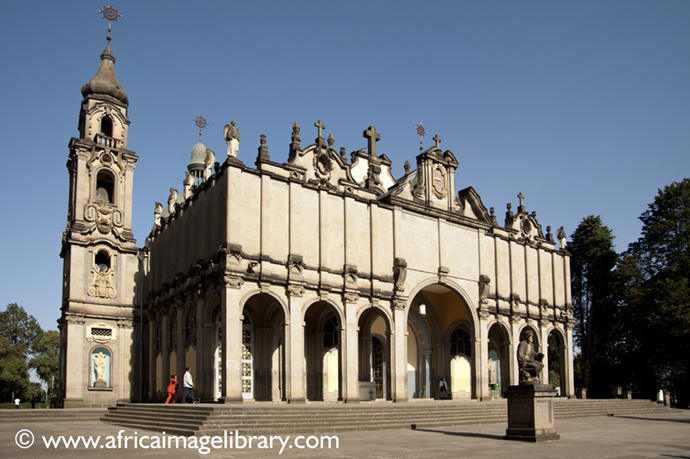
Spend a little time in the Ethiopian capital, and you’ll soon realise that its less savoury elements carry a lot more bark than bite. Easy to explore on foot, and tolerably safe even at night, districts such as the bustling Piazza, the modern and gleaming Bole Road, and the more down-at-heel Merkato all boast a compelling urban buzz. Addis Ababa also boasts a fantastic dining-out scene, some great nightlife and live music venues, and an engaging spread of museums, galleries and other worthwhile historic landmarks. Furthermore, Addis Ababa possesses a genuine sense of place lacking in those many other African capitals that were designed to be misplaced pockets of Western urbanity in otherwise underdeveloped nations. Indeed, perhaps the highest praise one can direct at chaotic, contradictory and compelling Addis Ababa is this: it does feel exactly as the Ethiopian capital should feel – emphatically and unmistakably a modern 21st-century city, but also singularly and unequivocally Ethiopian.
Axum
The oldest continuously inhabited town south of the Sahara, Axum (also spelt Aksum) sits at an elevation of 2,130m on the central Tigrayan Plateau, 1,000km north of Addis Ababa and 30km south of the Eritrean border. Historically and archaeologically, it is the most important city in Ethiopia; it also hosts the country’s first church, and forms the spiritual home of its unique brand of Christianity.
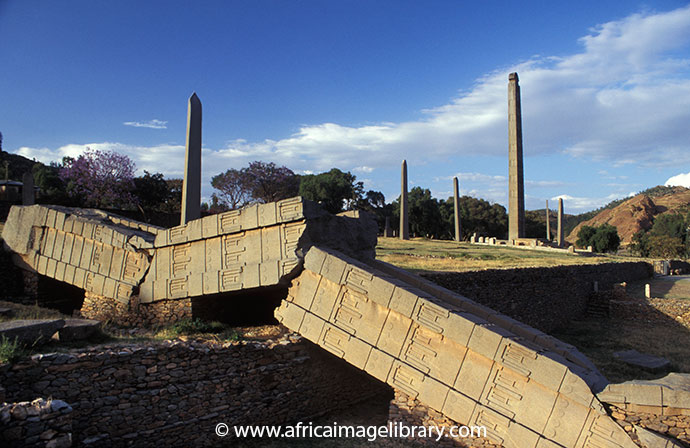
The most iconic monument at Axum is the field of 120-odd stelae, ranging from small, roughly hewn stones to finely engraved obelisks the height of a ten-storey building, concentrated within an area of 1,000m2 opposite the Cathedral of Maryam Tsion. The site incorporates what are probably the three tallest stelae ever erected in ancient times, neatly engraved blocks of solid granite that stand (or, in one case, stood) between 23m and 33m high. The stelae were excavated at the quarry at Gobo Dura, more than 4km to the southwest, and were most probably dragged to their present location by domesticated elephants. There’s no entirely satisfactory explanation for how the Axumite engineers erected these massive blocks of stone – tradition has it that the supernatural powers of the Ark of the Covenant were put into play, but a more rational explanation would involve pulleys and elephants.
Bale Mountains National Park
The most extensive and tallest range in southern Ethiopia, the Bale Mountains rise eastward from the Rift Valley and northwest of the arid Somali Region to an altitude of 4,377m at Tullo Deemtu, Ethiopia’s second-highest peak. Although heavily settled in parts, the mountains and their immediate environs incorporate around 6,000km2 of contiguous wilderness, much of which is covered in indigenous montane and medium-altitude forest. The regional centrepiece is the 2,200km2 Bale Mountains National Park (BMNP), which protects the range’s upper slopes, including the 250km2 Sanetti Plateau, which stands above 4,000m and supports the world’s largest tract of Afroalpine moorland.
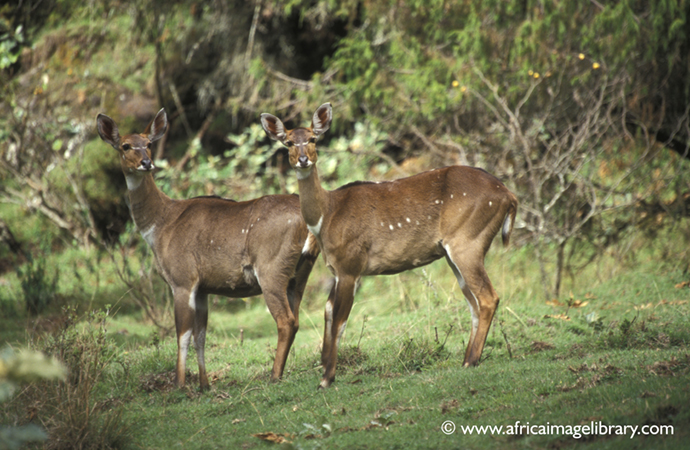
Offering some superb hiking and trekking possibilities, Bale Mountains National Park is also surprisingly easy to explore in a vehicle, with the Sanetti Plateau being traversed by the highest all-weather road in Africa (built by the Derg to provide an emergency access route to the south). The main attractions of the park are its wild alpine scenery and exceptionally diverse fauna, which includes the world’s largest population of the endangered Ethiopian wolf and mountain nyala, and the unique Bale monkey. BMNP also offers some of the finest birdwatching in Ethiopia.
Danakil Depression
Straddling the Eritrean border to the east of the Tigrayan highlands, the Danakil, or Dallol, is an area of true desert that extends across the most northerly and volcanically active portion of the Afar Depression. It ranks among the lowest-lying places anywhere in the planet, dropping to 116m below sea level, while temperatures on the shadeless plains frequently soar above 50°C, and are exacerbated by a fierce gale known as the Gara (Fire Wind). This climatic inhospitality is mirrored by the reputation of the region’s nomadic Afar inhabitants, who traditionally eked out an income as salt miners and traders, transporting their wares by camelback to the Tigrayan highlands. As recently as the 1930s, the Afar of the Danakil were known to greet male strangers by lopping off their testicles. Today, while scrotal intactness is no longer a cause for concern, the desert-hardened Afar are unmatched when it comes to making life difficult for travellers and guides who don’t bow to their frequent and inventive demands for fees and tips. This, in short, is a challenging travel destination.
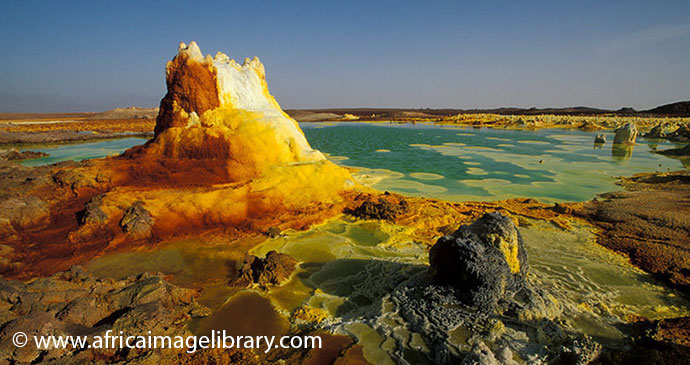
For all that, the Danakil is an area of singular geological fascination: a strange and at times beguilingly beautiful desert landscape studded with austere volcanic calderas, explosive cauldrons of bubbling red lava, malodorous sulphur-caked hot springs, recently solidified black lava flows, and vast, blinding salt flats that stretch for up to a kilometre below the surface. Until ten years ago, the Danakil was also firmly off the beaten track, attracting a couple of hundred visitors annually, but it has started to take off in recent years, not least due to the publicity it was afforded by the 2009 BBC documentary The Hottest Place on Earth, and up to 100 travellers might now overnight on Erta Ale on any given night in the high season. This growing popularity, coupled by a vast improvement in roads servicing the region, has made the Danakil far more accessible than it was a few years back. At the same time, the net worth of the ever-mutating plethora of fees charged by the local Afar has increased exponentially, making it near impossible to visit without an experienced Ethiopian guide who knows the area well and has a good relationship with the local authorities, pathfinders and militia.
Gondar
The so-called Camelot of Africa, Gondar is perhaps the most immediately impressive town along the historical circuit, studded as it is with fairy-tale castles, venerable churches and other substantial European-influenced buildings dating from its 17th- and 18th-century heyday. Imposing as they might be, however, Gondar’s handsome antiquities are arguably less intriguing and enduringly memorable than their more genuinely ancient and mysterious counterparts at Axum and Lalibela, for which reason we would rank it as the least-essential stop of the three for historically minded visitors with insufficient time to visit them all.
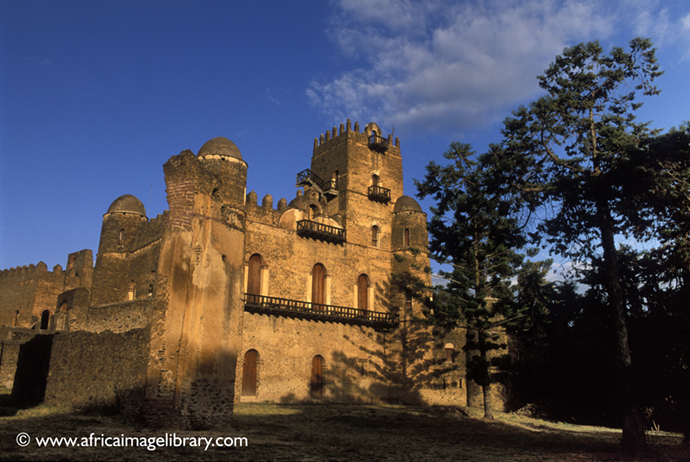
That said, the well-preserved castles and palaces that grace Gondar’s stone-walled Fasil Ghebbi, a UNESCO World Heritage Site, seldom disappoint, while the lavishly painted church of Debre Berhan Selassie and brooding 18th-century palatial complex at Kuskuam both rank highly on Ethiopia’s list of must-sees. Historical sightseeing aside, Gondar is a very pleasant city to explore, with a friendly, laid-back, almost countrified mood by comparison with Addis Ababa or even Bahir Dar. It boasts some excellent traditional restaurants and live music venues, and it’s also a good place to arrange overnight hikes in the nearby Simien Mountains.
Harar
The spiritual heart of Ethiopia’s Islamic community, the walled citadel of Harar is considered by some to be the fourth-holiest Islamic city after Mecca, Medina and Jerusalem. It is also an exceptionally pleasant city to visit: lively, welcoming and relaxed, yet possessing a cultural integrity and aura of lived-in antiquity that make it the most traditionalist of Ethiopia’s larger towns. Boasting a moderate highland climate, Harar lies at the centre of a fertile agricultural area, one renowned for its high-quality coffee and khat. But its focal point is Harar Jugol, the 48ha walled city, a UNESCO World Heritage Site whose innumerable winding alleys lead past 83 private and public mosques and the 102 qubi (shrines or tombs of important holy men) alluded to in the nickname Gey Ada (City of Saints).
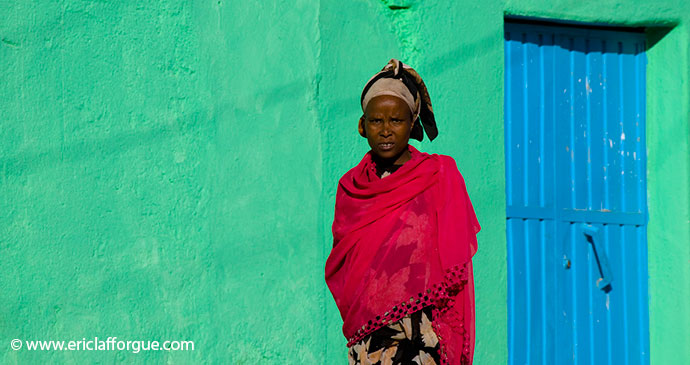
Considering the prominent role played by Harar in past Muslim–Christian–Oromo conflicts, the modern town possesses a refreshing mood of religious and cultural tolerance. Indeed, while Harar Jugol is deeply Islamic in character, the newer part of town, which runs west along the main road to Addis Ababa, is predominantly Orthodox Christian, and the frizzy-headed traditionalist Oromo are also much in evidence, particularly in the market areas. What’s more, for a city of such devout pedigree, Harar has an undercurrent that is more than a little hedonistic. The compulsive chewing of khat dominates every aspect of public life and, to paraphrase the sentiments of one Muslim resident, you really do need something liquid to chill you out after a good chew. Any preconceptions about fundamentalist Harar can be washed down at the bars which come close to matching public mosques one for one within the old city walls. All in all, Harar is the sort of easy-going, cosmopolitan town where you could settle in for a week and do nothing more exerting than just soak up the atmosphere.
Lalibela
Arguably the most impressive historical site anywhere in sub-Saharan Africa, the rock-hewn churches of Lalibela all lie within a roughly triangular 15ha area at the southern end of the town centre. There are two main clusters of churches, separated by a non-perennial rock-cut stream known rather grandiosely as the Jordan River (one of many place names that support the notion King Lalibela conceived of the church as a kind of ‘New Jerusalem’).
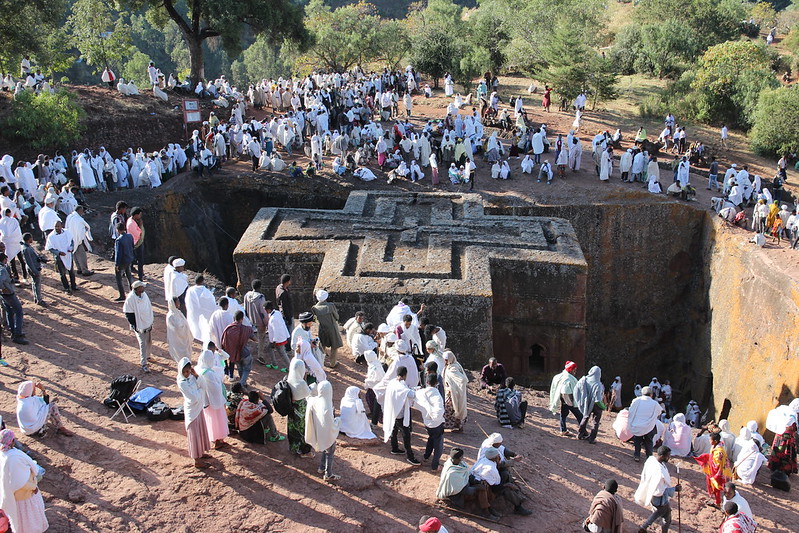
Lalibela is usually at its most compelling and spiritually rewarding in the early morning (ideally around 05.30), when masses are held at many of the churches and most tourists are still in bed or having breakfast. Most reliable for a large turnout at morning mass is Saturday, or any feast days associated with a particular saint, and any guide or hotel receptionist should be able to tell you which of the churches is likely to be your best bet on any given day. Once morning mass is over, tourists increasingly start to outnumber bona fide worshippers, and the churches start to feel like they are maintained less as active shrines of worship than as tourist attractions.
Simien Mountains National Park
Inscribed as a UNESCO World Heritage Site in 1979, the awesome Simien Massif, situated about 100km north of Gondar, comprises a high plateau of ancient volcanic rock incised with tall, precipitous cliffs and chasmic river valleys. The range includes at least a dozen peaks that top the 4,000m mark, among them the highest mountain in Ethiopia and fifth-highest in Africa, the 4,533m Ras Dejen (also known as Ras Dashen, and often given incorrectly as 4,620m high). In 1966, the most westerly part of the range was set aside as the 136km2 Simien Mountains National Park (SMNP), which has since been expanded eastward to incorporate Ras Dejen and several other comparably high peaks, to cover a total area of 412km2.
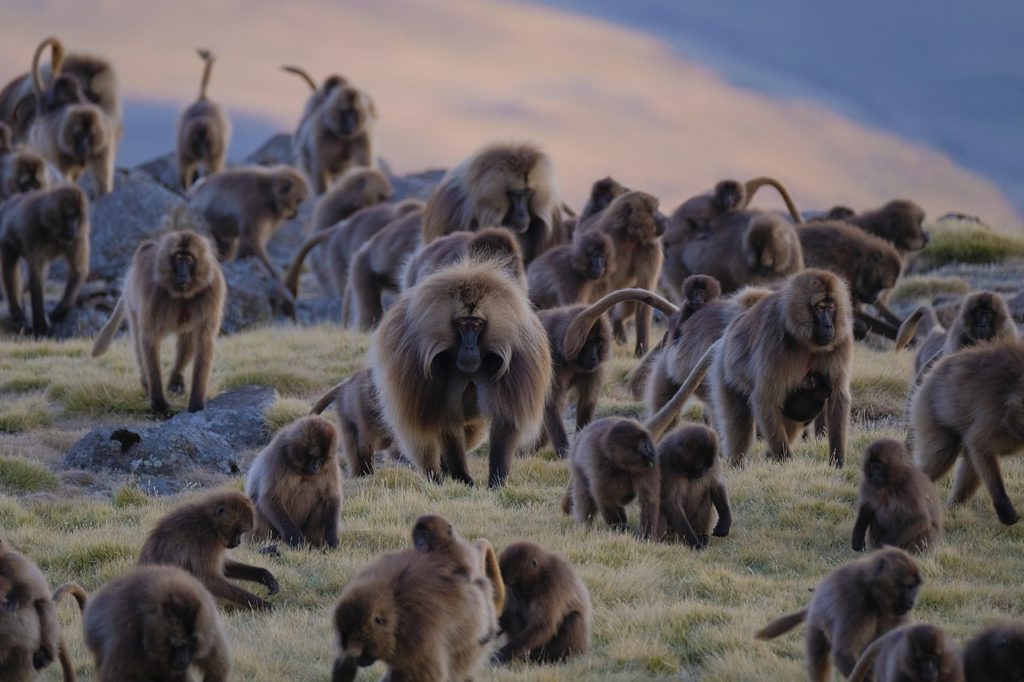
The park’s main attraction is the scenery, which is utterly breathtaking, but it is also an important sanctuary for endemic wildlife, being the only remaining stronghold for the endemic Walia ibex and one of the few protected habitats of the Ethiopian wolf and gelada monkey. SMNP is Ethiopia’s most popular trekking and hiking destination, best explored over a three- to ten-day hike or mule trek possibly incorporating an ascent of Ras Dejen and other peaks. However, the recent construction of a good all-weather road running deep into SMNP, as well as the opening of Simien Lodge close to the main entrance gate, has opened it up to overnight visits, and to less strenuous day walks and drives.
South Omo
Nothing in highland Ethiopia prepares one for South Omo. Nor, for that matter, does much else in modern Africa. It’s apocryphal, perhaps, but easy enough to believe when confronted by the region’s extraordinary cultural integrity, that there is more than a smattering of truth in the assertion that as recently as 50 years ago the people of South Omo were scarcely aware that such an entity as Ethiopia existed.
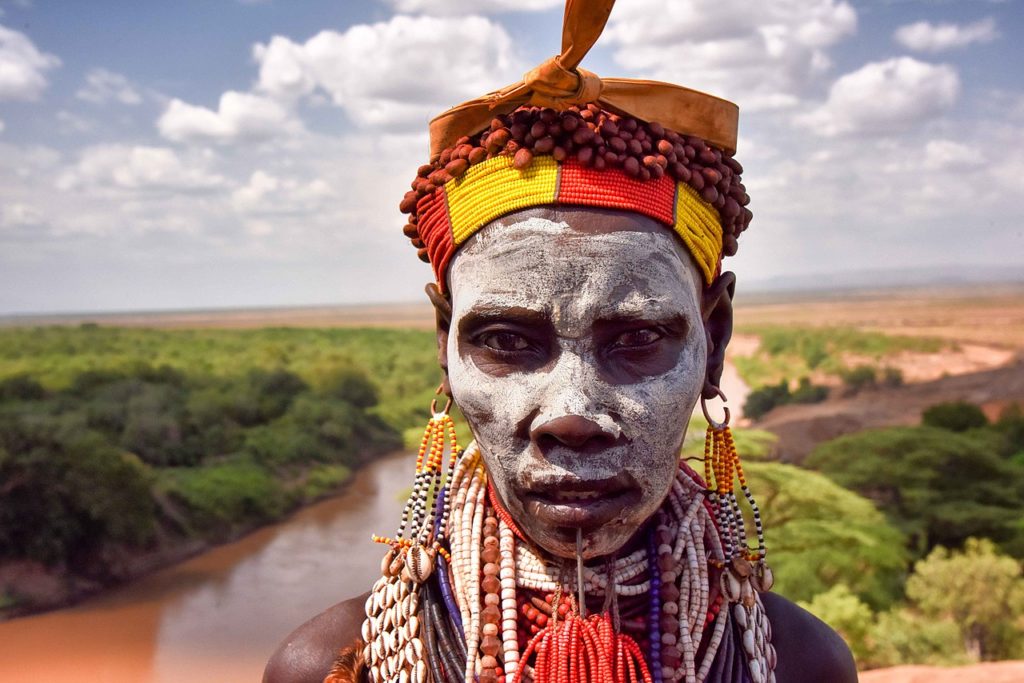
South Omo is literally fantastic. Descending from the green, urbane highlands into the low-lying plains feels like a journey not merely through space, but also through time, as one enters the vast and thinly populated badlands that divide the mountainous centre of Ethiopia from its counterpart in Kenya. Like much of neighbouring northern Kenya, South Omo is as close as one can come to an Africa untouched by outside influences. The culturally diverse, immaculately colourful and defiantly traditionalist agro-pastoralists who inhabit the region seem to occupy a physical and psychic landscape little different from that of their nomadic ancestors. This is Africa as it once was, or as some might still imagine it to be, and its mere existence is at once wonderful and scarcely credible.
Related books
For more information, see our guide to Ethiopia:
Related articles
Africa has some magnificent centuries-old rock art – how many have you visited?
From crumbling Persian empires to colossal Roman cities, here are some of our favourite ruined civilisations from around the world.
This isn’t one for claustrophobes.
Marble caves, salt lakes and rainbow mountains.
We take a look at some of Ethiopia’s most unusual animals.
